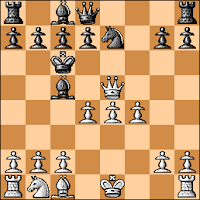
I'm not an endgame maven.
I have plenty of endgame books, but I have worked my way through only two or three of them.
Still, I know a few little things about endgames. Especially the ones that "haunt" me.
Take the following position. It's from a recently completed FICS blitz game of mine, and it's pretty simple.

Despite the fact that it was snowing outside, I had some food on the grill and I was taking a break inside to warm up. Why not a quick online game of chess before dinner?
When I reached this position, I thought "My opponent's played well, I should force the draw, split the point, and get back to the chops."
Wrong!
Of course I played 36.c5 – which does lead to a draw – but in my careless "thinking" I overlooked that the alternative 36.b5 wins.
After the game's simple 36...bxc5 37.bxc5 things were clear: I can trade my c-pawn for Black's e-pawn, and then capture his h-pawn, but my remaining passer will not be able to get to its queening square (see "All's well that ends well" for a similar theme) without stalemating the enemy King – or being stalemated myself

About 25 years ago I played in a small tournament that saw, in the final round, a similar position. The odd thing was that if Black could have held the draw back then, 8 out of 10 (or 12) of us would have tied for first place (and probably each would have won enough prize money to spend on a call home from a public phone booth).
37...Kd5 38.c6 Kxc6 39.Kxe4 Kd6 40.Kf4 Ke6 41.Kg4 Ke5 42.Kxh4 Kf4

Of course, Black can, instead, race to h8 and keep the pawn from getting there. In this position, he can keep the White King from getting out from in front of the pawn by shadowing him up and down their respective files.
43.Kh5 Kg3
Huh?
44.h4
The cat is out of the bag.
44...Kf4 45.Kg6 Kg4 46.h5 Kf4 47.h6 Black resigns
(Dinner was great, too.)

 Jerome Gambit 101.
Jerome Gambit 101. 7.Qf5+ Kd6 8.f4 Ne7
7.Qf5+ Kd6 8.f4 Ne7  Last seen in my game against TheChessInnovator (see "
Last seen in my game against TheChessInnovator (see "



















 The good old Two Knights Defense.
The good old Two Knights Defense. Ha! says my opponent (in my imagination, anyhow).
Ha! says my opponent (in my imagination, anyhow).  Transposing to a "modern" Jerome Gambit: 1.e4 e5 2.Nf3 Nc6 3.Bc4 Bc5 4.Bxf7+ Kxf7 5.0-0 Nf6.
Transposing to a "modern" Jerome Gambit: 1.e4 e5 2.Nf3 Nc6 3.Bc4 Bc5 4.Bxf7+ Kxf7 5.0-0 Nf6. Move quickly, avoid a blunder, I have an extra piece...
Move quickly, avoid a blunder, I have an extra piece...
 Better 19...Bxb3. The clock is ticking down, but I have more time than my opponent, who now slips...
Better 19...Bxb3. The clock is ticking down, but I have more time than my opponent, who now slips... 22.Re1 Re8 23.g3 Bd4 24.Rxe8+ Bxe8 25.Kg2 Bg6 26.Kf3 Bb1
22.Re1 Re8 23.g3 Bd4 24.Rxe8+ Bxe8 25.Kg2 Bg6 26.Kf3 Bb1 There's enough time left for this to decide the game.
There's enough time left for this to decide the game.